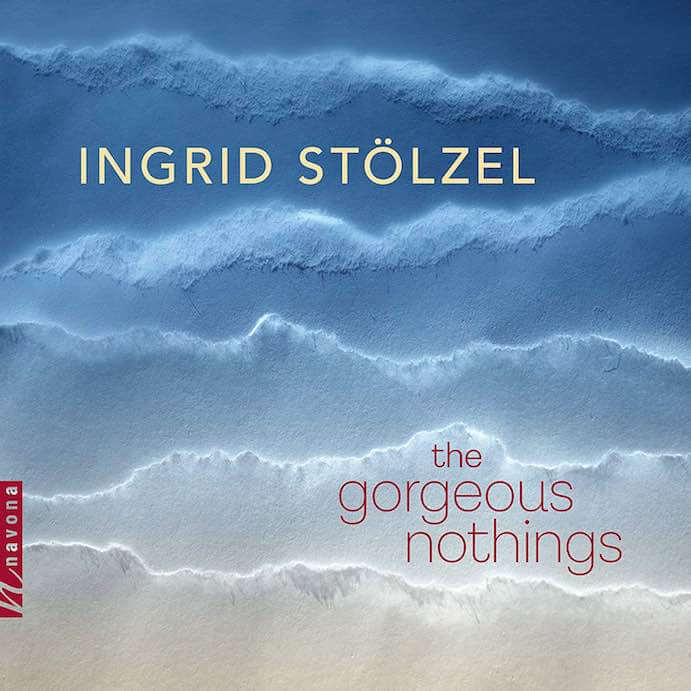Ingrid Stölzel has a gift for evoking a sense of longing. One listen to any of the pieces on her new album The Gorgeous Nothings, released on Navona Records, makes this instantly evident. Despite the album’s breadth of music, which includes two song cycles and three standalone pieces, it finds its cohesiveness through its consistent exploration of our humanness: our search for meaning, our mortality, and the inevitable struggles that come with our existence.
The star of the album is The Gorgeous Nothings, featuring Sarah Tannehill Anderson (soprano), Anne Gnojek (flute), Margaret Marco (oboe), and Ellen Sommer (piano). The song cycle sets fragments found in Emily Dickinson’s complete envelope writings, many of which deal with Dickinson’s thoughts on mortality and spirituality. The piece provides flowing, lyrical melodies for Anderson and constantly shifts between consonance and dissonance in the accompaniment, oscillating between feelings of comfort and conflict throughout each movement.
Oftentimes, the accompaniment for The Gorgeous Nothings feels as if it could belong in a singer-songwriter’s piece – it is simple, and at times quite sparse, but effectively sets an introspective mood. The first movement, “Clogged Only With Music,” begins with a slow piano line that evokes a sense of foreboding, which is echoed by a snaking soprano melody. With the first entrance of flute and oboe, the piece shifts into a major key and the instrumentalists play with a brighter tone. The mood becomes optimistic and cheerful as the soprano line rises and the collective sound grows, crescendo-ing joyfully until it feels as if the sound is bound to burst at any second. In these brighter sections, the piece is far more like lieder or art music, and these stark shifts give us powerful insight into Stölzel’s interpretation of Dickinson’s poetry.
The Gorgeous Nothings is most successful in its brooding sections when Anderson sings with beautiful straight tone, quiet and light but still warm and full. Take, for example, the start of “In This Short Life,” which is scattered with moments of suspense where Anderson is left singing alone, unaccompanied. Immediately, we hear the restraint in the singer’s voice and feel the emotional tension, which makes sense given the text’s contemplation of our mortality. Anderson’s grittier sound is honest, exposed. It conveys a vulnerability that is ideal for Dickinson’s existential ponderings.
It is more difficult to engage with the poetry once Anderson opens up to her fuller, more traditional operatic sound, typically used in the cycle’s more hopeful moments. The pure authenticity evoked by her folkier sound dissipates when she uses a fuller tone, creating a slight disconnect between performance and text. How would the overall aesthetic of the piece differ if Stölzel had directed Anderson to use straight tone throughout the entire piece, or had chosen a vocalist whose style lived primarily on this end of the spectrum?
The same question is present throughout Soul Journey – Three Whitman Songs. While the album’s second song cycle–which features Phyllis Pancella (mezzo-soprano) and Ellen Sommer (piano)–also uses accompaniment that is simple and sparse, Pancella’s vocal stylings consistently live in the world of “art music.” She never ventures into the alternative sound that Anderson explores, making Soul Journey less striking as a whole.
Ingrid Stölzel–Photo by Cristian Fatu
Every piece on the album combines piano accompaniment and soloist(s), and despite Stölzel’s repeated use of this model, each piece manages to develop its own identity. With Eyes Open consists of shimmering, fluid alto saxophone lines (Keith Bohm) and occasional high, twinkling piano arpeggios (Ellen Sommer), which create a reflective and serene soundscape that makes you want to curl up on your windowsill to re-listen on a rainy day. The Road is All is similarly calm, and its piano accompaniment (Robert Pherigo) is just as light. What separates this piece is the interaction between the violin (Anne-Marie Brown) and cello (Lawrence Figg), which alternate between playing solo legato lines and diving into cascading, harmonious duets; their relationship adds an extra layer of depth to Stölzel’s portrayal of the subjects’ pain, almost as if the two are separate narrators telling the story together.
This album raises questions about the future of vocal styling in conservatories and “classical” institutions. As composers continue to write freely from the limitations of genre, working with the full sound palettes available to them, how will the values of these institutions shift? At what point will the gritty indie singer stand on even ground with the conservatory-trained soprano, making their way more consistently into studios for collaborations with “classical” composers?

